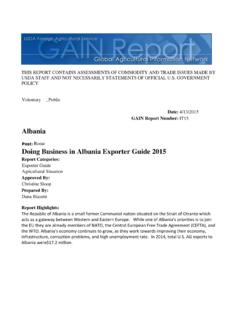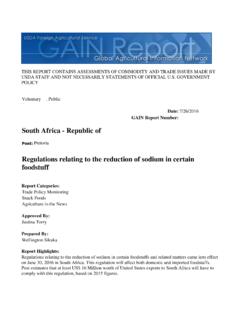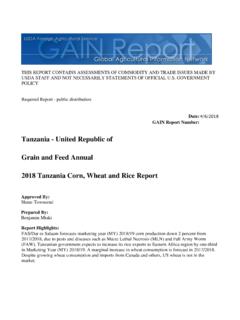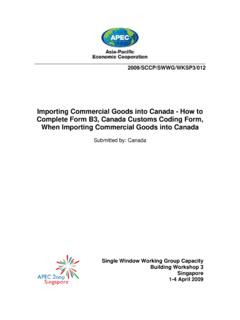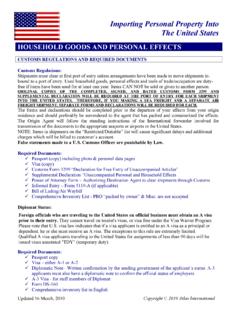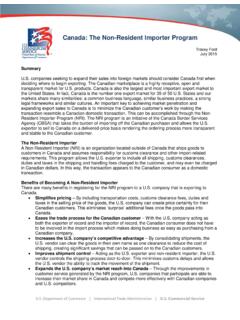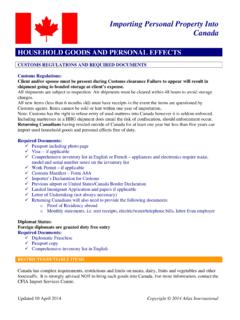Transcription of Canada Exporter Guide Exporting to Canada: A Practical Guide
1 THIS REPORT CONTAINS ASSESSMENTS OF COMMODITY AND TRADE ISSUES MADE BY USDA STAFF AND NOT NECESSARILY STATEMENTS OF OFFICIAL GOVERNMENT POLICY Date: GAIN Report Number: Approved By: Prepared By: Report Highlights: Canada is among the top destinations for agricultural exports, in Fiscal Year 2012 agricultural exports to Canada reached $20 billion in agriculture and fish products. This reflects an increase of from the previous year. Consumer-oriented agricultural products accounted for 77 % of total food and agricultural product sales to Canada in FY2012 with red meats, fresh vegetables, fresh fruits, snack foods, and processed fruits and vegetables, coffee extracts and preparations as the category leaders.
2 This report is a Practical Guide for food exporters interested in the Canadian market, highlighting consumer and product trends, market sector reports, and best prospects for consumer-oriented agricultural products in the Canadian market. Post: Ottawa Maria Arbulu Scott Reynolds Exporting to Canada : A Practical Guide Exporter Guide Canada CA 12049 12/21/2012 Required Report - public distribution Canada : Exporter Guide December 2012 3 | P a g e Table of Contents SECTION I. MARKET OVERVIEW .. 4 A) General ..4 B) Consumer Trends in Retail Food ..5 SECTION II. MARKET SECTOR STRUCTURE AND TRENDS .. 8 Market Sector Reports ..10 SECTION III. BEST HIGH-VALUE PRODUCT PROSPECTS .. 13 What s Hot?
3 13 SECTION IV. ROAD MAP FOR MARKET ENTRY .. 15 Entry Strategy ..15 SECTION V. FREQUENTLY ASKED QUESTIONS AND THEIR ANSWERS .. 17 SECTION VI. CONTACTS .. 19 Summary of Useful Websites ..19 SECTION VII. Exporter SERVICES, BUSINESS PROCEDURES, AND FOOD .. 20 A) Export Services for Food and Agricultural Exporters ..20 B) Business Customs Import Sample Products ..24 C) Food Regulations ..26 Labeling Requirements ..26 The Guide to Food Labeling and Advertising in Canada ..28 Food Labeling Information Service ..28 Labeling of Shipping Containers ..31 Nutrition Labeling ..31 Allergen Labeling Regulations on Pre-packaged Foods ..33 Tariffs and Tariff Rate Quotas (TRQs) ..34 Packaging and Container Regulations.
4 35 Food Additive Regulations ..36 Pesticides and Other Contaminants ..37 D) Other Regulations and Requirements Inspection and Registration Fees ..37 E) Other Specific Standards ..39 Food Marketing Authorizations ..40 Test Marketing Authorization (TMA): Processed Food Products ..41 Copyright and/or Trademark Laws ..42 The Use of Health Claims ..43 Labeling Claims on Meat, Poultry and Fish Products ..44 Fish and Seafood ..45 Novel Foods (Foods Containing Genetically Modified Crops) ..45 Halal Foods ..46 Kosher Foods ..47 Baby Foods ..47 Organic Foods ..47 Pet Food ..48 Livestock Wine, Beer and Other Alcoholic Beverages ..50 Vitamins, Minerals, Probiotics, and Supplements ..51 F) Recent Regulatory Initiatives and Proposed Changes Under Review.
5 52 Other Label Changes Sodium Diacetate ..52 Meat Packaging Registration ..52 New Regulations Under Development to Address Regulatory Gaps in Imported Food Sector ..53 Appendix I. Statistics .. 55 Glossary of Acronyms .. 58 Canada : Exporter Guide December 2012 4 | P a g e SECTION I. MARKET OVERVIEW A) General According to the trade statistics published by the Census Bureau, Canada continues to rank as the top destination for consumer-oriented (high value) agricultural exports. In fiscal year 2012 (FY 2012), agricultural exports to Canada reached $ 20 billion. This reflects an increase of from the previous year Agricultural exports from the United States to Canada accounted for 14% of global food and agricultural product exports of $ 136 billion.
6 Consumer-oriented agricultural products accounted for 77 percent by value of total food and agricultural export sales to Canada in FY2012. The leading products were red meats, fresh vegetables, fresh fruits, snack foods, and processed fruits and vegetables, coffee extracts and preparations, breakfast cereals, and fruit and vegetable juice products. Products from the United States accounted for 59% percent of total Canadian agricultural and food imports in 2011. During FY 2012, the majority of consumer-oriented agricultural categories such as fresh fruits, red meats, snack foods, fresh vegetables, breakfast cereals, pet foods, wine and beer, tree nuts, posted record annual sales to Canada . The top five categories were red meat ($ billion), fresh fruits ($ billion), snack foods ($ billion), fresh vegetables ($ billion), and processed fruits and vegetables ($ billion).
7 Canada is also an important market for fish and forestry exports. Canada is the second largest export market for fishery products, and exports reached $ 893 million in FY2012. Despite being a major producer and world Exporter of forest products, Canadian imports of forest products reached $ billion in FY 2012. Combined agricultural, fishery, and forestry product exports to Canada reached $ billion. The United States and Canada have the world's largest bilateral trading relationship. During CY 2011, two-way merchandise trade of all goods was valued at $ 681 billion. The number of trucks that cross the Canada border daily exceeds 20,000 per day. That is an average of almost one truck every-other minute, 24 hours a day.
8 Total bilateral agricultural trade between the United States and Canada reached $ 40 billion in FY2012, or approximately $ 110 million per day. Under the tariff elimination provisions of the North American Free Trade Agreement (NAFTA), the majority of agricultural products have entered Canada duty-free since January 1, 1998. On December 4, 1998 the United States and Canada signed a Record of Understanding, an agreement to further open Canadian markets to farm and ranch products. Since that time, agricultural exports have tripled in Trade with Canada is facilitated by proximity, common culture, language, similar lifestyle pursuits, and the ease of travel among citizens for business and pleasure.
9 Many products have gained an increased competitive edge over goods from other countries as the result of the FTA/NAFTA. Also manufacturers generally have a competitive advantage over Canadian manufacturers in the scale of production. Canada s grocery product and food service trades have been quick to seize opportunities under FTA/NAFTA, which permit them to expand their geographical sourcing area to include the United States. Declining import duties under the trade agreements and an easing of Canadian packaging requirements for processed horticultural products for the food service market have 1 US Fiscal Year 2012 (FY12) began on October 1, 2011 and ended September 30, 2012. 2 1998 agricultural exports to Canada were valued at $ billion.
10 Canada : Exporter Guide December 2012 5 | P a g e resulted in significant gains in the Canadian market for consumer-ready foods and food service foods. However, as similar as the United States and Canada are, there are differences that exporters need to recognize. Understanding the nuances of a marketplace is critical to a successful launch of a product in any foreign market. Canadian Market Overview Summary Advantages Challenges Proximity A sophisticated selection of product is already available in the Canadian market Wide exposure to culture Bilingual (English and French) labeling required for retail products Similar consumption and shopping patterns Differences in standard package sizes High brand awareness Differences in nutrition labeling Frequent business and personal trips to United States Conversion of measurements to metric system required Ease of entry for business travel Standard Canadian English required Duty free tariff treatment for most products under NAFTA Tariff rate quotas for certain products High quality and safety perceptions Differences in chemical residue tolerances origin top choice among imported foods Higher landed costs, especially for small shipments B)


